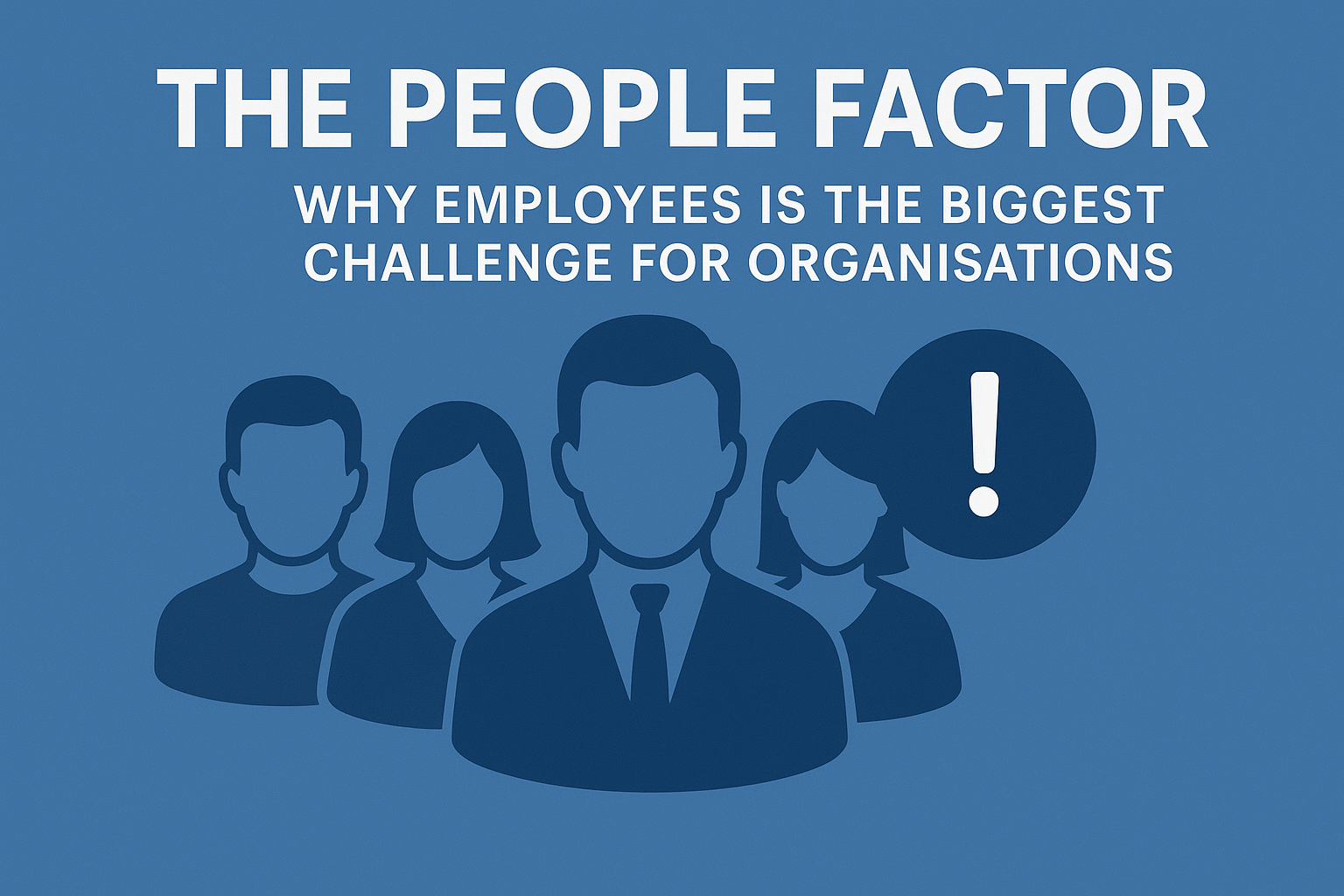In today’s fast-paced business environment, organisations frequently look to technology as the key to staying competitive. However, many overlook a crucial, often more challenging factor: people. While technology can enhance efficiency and innovation, it is ultimately the people behind the machines who determine an organisation’s success or failure. The “people factor” is often the biggest obstacle organisations face. Employees who may be disengaged, misaligned with the company’s goals, or resistant to change can severely impact an organisation’s progress. In this article, we’ll explore why addressing human factors within the organisation is far more critical than focusing solely on technological advancements.
Understanding the “People Factor”
The “people factor” refers to the human elements that influence an organisation’s performance, such as employee morale, leadership quality, interpersonal relationships, and company culture. Companies are built on individuals who must collaborate, communicate, and align with organisational goals. Poor people management can lead to miscommunication, disengagement, and ultimately, failure to meet business objectives.
The Myth of Technology as a Fix-All Solution
Organizations today often fall into the trap of believing that investing in the latest technology will solve all operational problems. However, without a motivated and well-managed workforce, even the most advanced technology will fail to deliver.
Technology cannot Replace Human Dynamics
Machines can streamline processes, but they cannot replace the human aspects of decision-making, creativity, and empathy. People remain central to an organisation’s culture and long-term success.
People’s Problems Are More Complex Than Technology Issues
Unlike technology, people are emotional beings with complex motivations, desires, and fears. Managing these emotions requires empathy, leadership, and an understanding of human psychology—something no machine can replicate.
Technological issues often have clear, concrete solutions, whereas people problems require tailored approaches that consider the nuances of individual and team dynamics. There’s no “off-the-shelf” fix for the human factor.
How the People Factor Impacts Technology
Even the most advanced tools can be rendered ineffective by poor human execution. Employees who are poorly trained or disengaged are more likely to misuse technology, causing inefficiencies and errors.
Successful technology adoption depends on how well people are trained and their willingness to embrace new tools. Poor change management can derail even the most robust technological initiatives.
Technology can automate tasks, but it cannot resolve issues related to company culture, leadership misalignment, or interpersonal conflicts. These issues must be addressed through people-focused strategies.
Common People Problems in Organisations
Change is inevitable, but people often resist it. Whether due to fear of the unknown or a lack of trust in leadership, this resistance can stall organizational progress.
Leadership plays a crucial role in aligning company vision with employee efforts. When leaders fail to clearly communicate or inspire, it can lead to confusion, low morale, and inefficiency.
Disengaged employees are less productive, creative, and likely to leave the organization. Studies have shown that disengaged employees cost businesses billions annually due to lost productivity and higher turnover rates.
Addressing the People Factor: Key Strategies
Organisations need strong leaders who can inspire, motivate, and effectively manage teams. Leadership development programs can equip managers with the skills they need to navigate complex human dynamics and align people with organisational goals.
A strong company culture promotes employee satisfaction, retention, and productivity. Companies should invest in creating an inclusive, engaging environment where employees feel valued and aligned with the company’s vision.
Since resistance to change is a natural human reaction, implementing effective change management processes can help employees transition smoothly during periods of organizational transformation. This includes transparent communication, training, and involving employees in decision-making.
Organisations thrive when employees feel heard. Encouraging transparent, two-way communication between employees and management fosters trust and minimises misunderstandings that can hinder progress. Establishing feedback mechanisms allows employees to voice concerns, ideas, and suggestions. This not only improves morale but also helps management address potential issues before they escalate.
The Costs of Ignoring the People Factor
When companies neglect the human side of their operations, they risk higher employee turnover, which can be costly in terms of recruitment, training, and lost productivity.
Disengaged employees or those in poorly managed environments tend to be less productive. This inefficiency costs organisations both time and money.
Balancing Technology and People for Organisational Success
The most successful organisations balance their investments in technology with a deep commitment to addressing the people factor. When employees are engaged, empowered, and aligned with the company’s goals, they are far more likely to utilise technology effectively.
Leadership should prioritize the human side of business operations, ensuring that employees are motivated, well-trained, and aligned with organizational goals before implementing new technologies.
The Imperative to Solve the People Factor
Organisations must prioritise the people factor if they want to thrive in today’s competitive landscape. Technology is a powerful tool, but without a motivated and engaged workforce, its potential remains untapped. By investing in leadership, fostering a strong culture, and addressing employee concerns, organisations can build a foundation where both people and technology can work in harmony to drive success.
FAQs
How can organisations balance technology and people management? Organisations can balance both by investing equally in leadership development, employee engagement, and technological tools, ensuring that people are well-equipped and motivated to make the most of new technologies.
Why is the people factor more important than technology? The people factor is crucial because employees are the ones who drive innovation, utilize technology, and align with organizational goals. Without addressing human elements, technology alone cannot guarantee success.
How can leadership solve the people factor issue? Leadership can solve people problems by promoting open communication, fostering a positive culture, and investing in training and development programs that align employees with the company’s vision.
What are the common people-related challenges organizations face? Common challenges include employee disengagement, resistance to change, poor leadership, and lack of alignment with organizational goals.
Can technology solve cultural issues within an organisation? No, technology cannot resolve cultural or interpersonal conflicts. These require human-focused solutions such as improved leadership and communication strategies.


